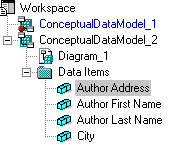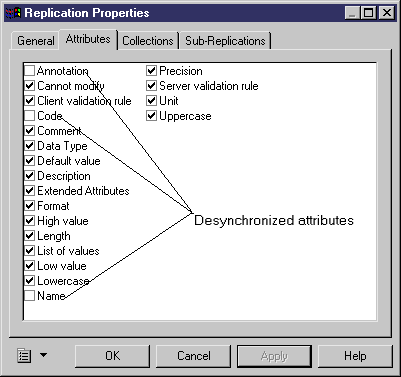While shortcuts allow you to reference objects in other models, they have some limitations:
For example, in one model you may need a Client table with Name and detailed Address columns, while in another model you may need only the Name column.
In this case, instead of using a shortcut, you should replicate the object.
When you replicate an object, PowerDesigner creates a complete copy (or replica) of the object. The replica retains the name, code, type and Id of the original object and is automatically updated when the original is modified.
A replica looks exactly like other objects in the Browser and diagram, but its property sheet is, by default, uneditable, because all its properties are synchronized with the original:

You can desynchronize any property that you want to change, while retaining synchronization of the others.
The link to and synchronization with the original object is maintained by a replication, which is not visible in the Browser or diagram, but whose properties are accessible via the List of Replications.

You Use Shortcuts when
You want to reference an object in the same model or in different models or packages in order to share this object representation between models or packages. The shortcut is not a local copy of the target object and cannot be modified independently of its target object.
You Use Object Replications when
You want to have a local copy of an object that can also diverge from its original object.
Objects that Support Object Replications?
You can create as many replicas as you want for most of the object types that appear under a model diagram or package in the Browser.
You can also create replicas of replicas.
You cannot replicate links, but you can create a link between two replicas in the referencing model.
The following table lists objects per module that support replications:
|
Module |
Object |
|---|---|
|
CDM Conceptual Diagram |
Entity, Data Item |
|
PDM Physical Diagram |
Table, View, User, Role, Group, Abstract Data Type, Test Data Profile, Storage, Tablespace, Procedure, Trigger Template, Trigger Template Item, Join Index, Sequence, Database Package, Synonym |
|
PDM Multidimensional Diagram |
Cube, Dimension, Fact, Data Source |
|
OOM Class Diagram |
Class, Interface |
|
OOM Use Case Diagram |
Use Case, Actor |
|
OOM Sequence Diagram |
Object, Actor |
|
OOM Activity Diagram |
Object State, Organization Unit, Object, Activity |
|
OOM Component Diagram |
Component |
|
OOM Object Diagram |
Object |
|
OOM Deployment Diagram |
Component Instance, Node |
|
OOM Collaboration Diagram |
Object, Actor |
|
OOM Statechart Diagram |
Event, State |
|
BPM Business Process Diagram |
Organization Unit, Resource, Message Format, Data, Service Provider, Event, Data Transformation, Variable, Correlation, Process, Correlation Key |
|
XSM XSD Diagram |
Attribute Group, Attribute, Element, Simple Type, Complex Type, Group, Notation, Import, Include, Redefine |
|
XSM DTD Diagram |
Entity, Attribute Group, Attribute, Element, Group, Notation |
|
RQM |
Term, User, Group, Replication |
|
ILM Information Liquidity Diagram |
— |
|
All modules |
File, Business Rule, Domain, Data Source |